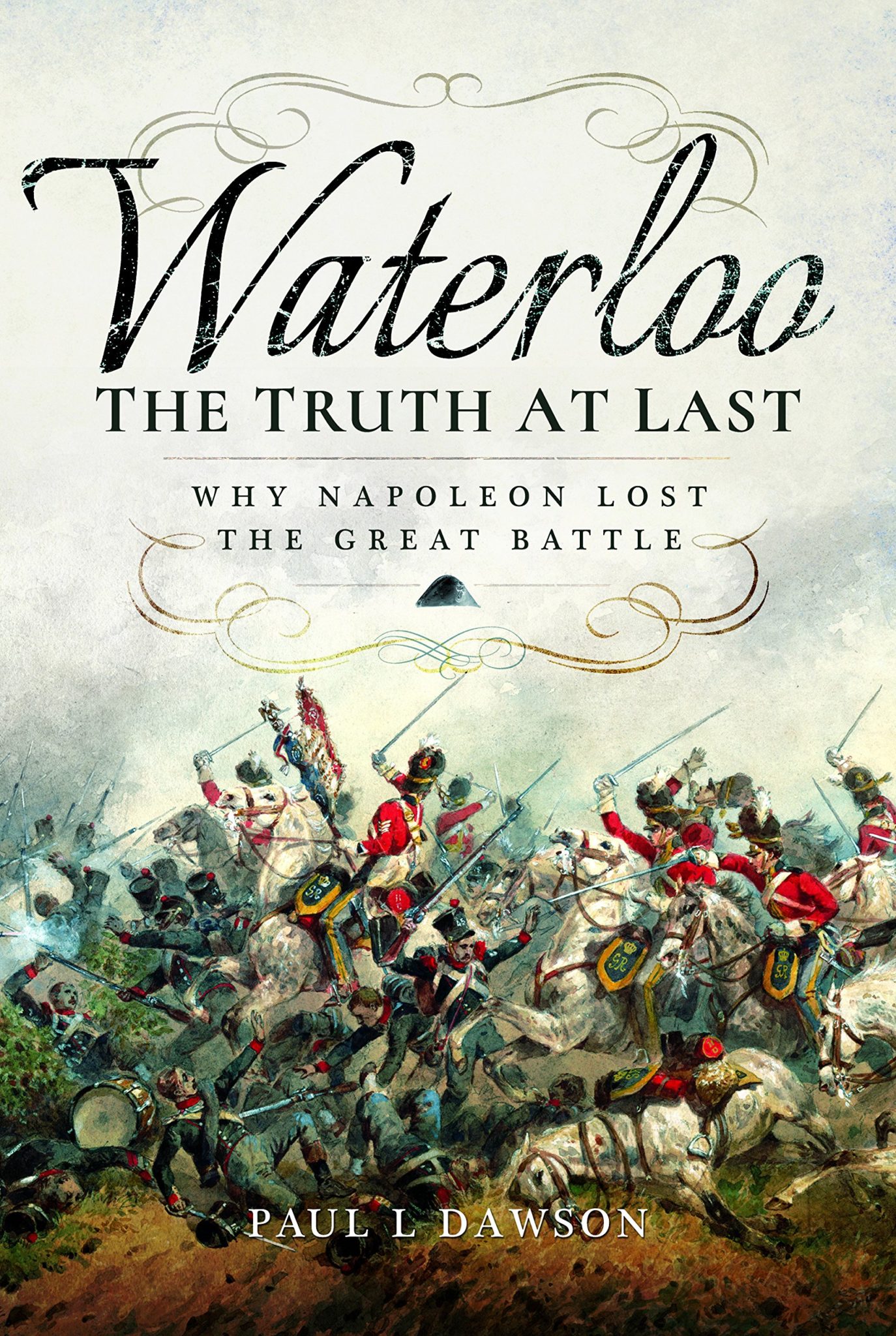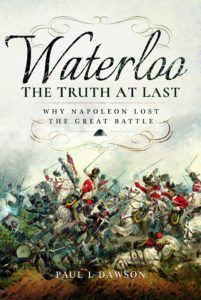

Waterloo: The Truth at Last.
Why Napoleon Lost the Great Battle
by
Paul L. Dawson
(978-1-52670-245-6, Frontline Books an imprint of Pen & Sword Books Ltd, 2018)
A Review by Alasdair White PhD FHEA FINS
Once in a while a book is published, the central hypothesis of which changes the paradigm of a subject and causes a fundamental rethink amongst the experts, neatly dividing them into ‘those that are ready for the change’ and those that ‘totally reject the change’. Such books appear infrequently in any field of study but amongst the plethora of books about the Battle of Waterloo they are a real rarity. One such book is Waterloo: The Truth at Last – Why Napoleon Lost the Great Battle by Paul L. Dawson (978-1-52670-245-6, Frontline Books 2018, $35.51 or £18.73).
The title, clearly and obviously a marketing ploy, is misleading and does not deliver on the expectations it raises. This is a serious history backed up by a depth of research which the author has attempted to analyse following a well-understood and respected procedure. It is not a populist, lightweight, gung-ho panegyric to Wellington (as the title implies) nor another deconstruction of Napoleon (also implied by the title). Dawson is a highly proficient and respected military historian of the Napoleonic era and his interpretation of the information he presents is thoughtful and profound. It also challenges a number of the myths and legends about the battle and this will cause raised hackles among the many who think they already know the ‘truth’ about Waterloo.
What Dawson has done is to research and collate contemporary data from the muster roles of the French army as they apply to the 1815 Belgium campaign, and particularly for the period 17-25 June 1815. The findings presented include the number of French dead and this results in a very different picture to that proposed by both Anglophile and Francophile historians.
As with any research, everything is really bound up in the interpretation and whilst Dawson is not suggesting that the basic events of the battle are somehow wrong, many of the myths and legends are examined, found wanting, and are debunked. And more importantly, the ‘why’ of the military decisions and movements come in for a very critical analysis. The result in each case is, of course, Dawson’s personal opinion and interpretation, but he does back up most of his findings with the use of memoirs (contemporaneously written and those written later) and, of course, the data. What is so interesting, however, is that the hard muster-roll data is used both to support the analysis and also to critically assess the memoirs and other documentary evidence.
Some of the results are startling.
Take for example the total losses experienced by the French at Waterloo – killed, wounded beyond further duty, prisoners, and missing presumed deserted. Scott Bowden in his 1983 book, Armies at Waterloo, quoted by Adkin in his 2001 work The Waterloo Companion, proposes that the French suffered 46,656 losses at Waterloo and during the retreat (18-26 June 1815). Dawson, on the other hand, using the Control Nominatif Troupe reports, which contain the muster lists for each regiment involved, concludes the actual figure is 23,087 of which just 1,093 were killed, 4,620 wounded, 10,183 taken prisoner, while 7,102 went missing (deserted?), leaving 89 who might have been killed, wounded, or deserted. This compares very favourably with the Allied and Prussian losses for the same period, which Adkin quotes as 24,000 in round numbers. Adkin’s figures suggest that around 4,700 Allies and Prussians died, and around 16,000 were wounded. However, he offers no supporting evidence or data for these assumed Allied and Prussian losses.
If we assume Dawson is right for the French and Adkin for the Allies and Prussians then the following conclusions look logical: (1) a total of 5,793 from all sides were killed during the battle, (2) 20,620 were wounded, (3) Allied and Prussian losses were higher than French losses, both in terms of numbers killed and numbers wounded – this might, of course be logical as the Allied forces were very static and thus easier targets than the French who were more mobile. One thing that is immediately obvious, though, the battle of Waterloo was nowhere near as bloody or deadly as historians have made out. And that is one of the main hypotheses of the book. Clearly, an historian now needs to investigate the Allied losses with the same vigour and production of data that Dawson has done for the French.
However, the book is flawed in a number of ways.
From the perspective of evidence-based analysis there is a highly disturbing number of errors in the tables of data suggesting very careless editing and checking, either by the author or the publisher. Of particular note is the table on page 469 which starts Chapter 25 entitled ‘The Analysis’ – only ONE of the cross totals is correct, although all the vertical totals are. This means that the final total is not 21,517 as printed but 21,067. It is easy to see how this would have occurred as data has to be transferred from other spreadsheets, but to get the totals wrong suggests careless manipulation of the data being presented (or phrased another way, perhaps the author didn’t know how to run totals in a spreadsheet!). Although this sort of issue should not raise concerns over the validity of the data nor over the interpretation offered by the author, it is, nonetheless, worrying and unfortunate in a book so painstakingly researched and put together.
The way the data is presented in the tables is not consistent and the column headings suggest different assumptions are in play in some cases (probably because differing sources are being used), but it would have been a far better book and far easier to use if the order of the data columns was the same across all the tables. And finally, on the subject of the presentation of data, it would have been useful if the author had included the opening muster figure for 17/18 June in the tables as this would have made the whole dataset more meaningful and avoided what was a frustrating and often fruitless search of the text to find these critical numbers in a consistent format. As a result of this presentational error, it is unclear whether Dawson actually has an accurate number of French troops on the battlefield on Sunday, 18 June 1815.
Other reviewers have offered their thoughts on Dawson’s narrative and interpretation and I shall leave readers to make up their own mind as to whether their arguments, or those of Dawson, are made convincingly. Similarly, one needs to remember that both Jonathan Abel and Gareth Glover, the two reviewers given below, are historians and authors who have their own take on the story.
https://networks.h-net.org/node/12840/reviews/1887229/abel-dawson-waterloo-truth-last-why-napoleon-lost-great-battle
As a person carrying out research on a regular basis, for me the most irritating thing about this book is not whether I agree or disagree with the author’s interpretation, nor his occasional lapses in the accuracy of his technical terms, but rather it is the completely unusable nature of the 26-page index in which people mentioned in the text are entered in the index under their rank and not under their family name. This makes finding other references to the same person a real chore if the reader has not noted down the man’s rank.
Finally, as a declaration of interest, I know and have enjoyed many discussions, both face-to-face and by email, with Paul Dawson who I consider to be a dedicated and highly proficient historian. He and I explored the data and his interpretation of what subsequently became Chapters 2, 3 and 10 concerning Hougoumont, making extensive use of my knowledge of Hougoumont and the surrounding grounds. We also discussed the subject of memories, how they were formed and why they are unreliable once immediate proximity to the cause of the memory ceases. Dawson has made extensive use of my input and my monograph, Of Hedges, Myths and Memories: a historical reappraisal of the château/ferme d’Hougoumont, published in 2016, for his
© Alasdair White 2018
